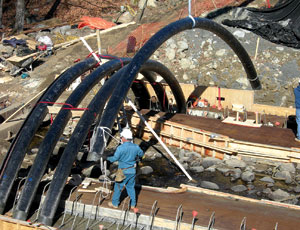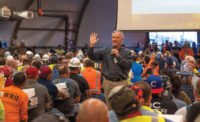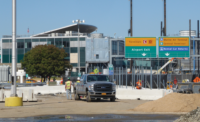In Maine, contractors are “blowing up” bridges: They are inflating hollow carbon-fiber tubes on-site, bending them into arches and infusing them with resin. Filled with concrete, the bridges are ready to be decked, backfilled and paved.

Brit E. Svoboda, chief executive of Advanced Infrastructure Technologies Inc., which owns the rights to the system, is hiking around the U.S. to promote its “bridge in a backpack”—and, yes, the tubes do fit in a backpack. “We are looking at bridges in Massachusetts and New Hampshire, and other states are starting to look for sites,” says Svoboda.
In Maine, the first bridge using the inflatable arches was built last year in Pittsfield. Developed by the Orono-based University of Maine’s Advanced Engineered Wood Composites (AEWC) Center, the 44-ft-long, 35-ft-wide Neal Bridge required 23 arches spaced 2 ft apart. Once the concrete was pumped in and cured, crews covered the 1-ft-dia arches in a corrugated composite material and backfilled; then, retaining walls of composites and precast concrete were built. The whole process took about two days. Even as a first-time job, the $600,000 project was cost-competitive with traditional bridges, says Habib Dagher, AEWC director.
The bridge drew a visit from U.S. Dept. of Transportation Secretary Ray LaHood, a licensing agreement with Orono-based Advanced Infrastructure and Randy Gardner, the owner of Bangor-based Gardner Construction Enterprises who formed a partnership with AEWC for the second bridge.
Predicted Widespread Use
Using no cranes, contractors built the 28-ft-long bridge in 11 days for $89,350. The learning curve was in realizing the method’s simplicity, says Gardner. “In my opinion, as soon as this gets [American Association of State Highway and Transportation Officials] certification, this will be in widespread use,” he says.
“Height is the biggest issue,” constructionwise, he notes. “[With an arch] the longer it is, the higher. In some cases you can alter the approaches, but not all. Lack of space would mean restrictions,” Gardner says. Another hurdle to clear is the contracting process. “For us to get a contract, everything has to be engineered,” says Svoboda. “States are committed to the technology, but it’s a matter of finalizing the engineering and writing the contracts. The inflatable-bridge part is only 10% of a total job. Any contractor can bid using our system along with concrete slabs, arches, steel.”
Gardner plans to do just that, but the bid process still poses obstacles. “One issue we’re running into is that … a contrator’s alternative proposal is not available until you’re the low bidder,” he says.
But thanks in part to a gubernatorial push for composites and the Maine Dept. of Transportation’s commitment, the state has scheduled a half-dozen “backpack” bridges to be built through 2011. The technology already has evolved so that it is cost-comparable with or lower than traditional alternatives, even timber, in the bidding process, claims Dagher. According to AEWC, the technology results in half the carbon footprint created by building traditional bridges.
Nathaniel Benoit, Maine DOT bridge program manager, says bids are in hand for the first of three projects this spring. Wyman & Simpson Inc., headquartered in Richmond, Maine, submitted the low bid of $764,164 for the 38-ft-long Auburn Royal River Bridge; Advanced Infrastructure’s $140,000 contract for manufacturing brings the total to $900,000. A conventional bridge would have cost about $850,000, says Benoit.
“We could have built a bridge 60 to70 ft long behind the existing abutments,” he notes. “The advantage [with the tubes] is we’re left with a buried structure.” Time isn’t always an advantage, but there are advantages in lightness, flexibility and long-term maintenance, Benoit adds.
Svoboda understands composites technology will not be right for every application. “There’s a niche for us, and we’ll push to fill it,” he says.




Post a comment to this article
Report Abusive Comment